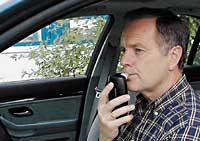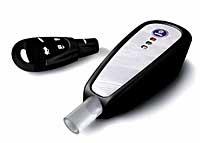Please blow up!

The traffic rules are progressively tightening throughout Europe. And as for alcohol, most countries have been marked as limits similar concentrations of alcohol. These concentrations, recommended by the European Commission, are 0.5 g/l in blood for drivers in general and less than 0.2 g/l for novel drivers, trucks with heavy or dangerous loads and public transport drivers.
This means that a driver cannot contain 0.5 g of alcohol – ethanol – or more than one liter of body blood. Or put another way, before taking the car, the motor or the bike can not drink more than two or two beers or a couple of small wines, you have to be careful.
In addition, in Spain, in the summer of 2005, the system of card per points is being launched. The idea is not new, of course, since it is underway in many European countries for a long time. In addition, it has left the French system, which is giving good results. If you breathe between 0.25 mg/l and 0.75 mg/l, four points of the first twelve will be lost and six points will be removed from 0.75 mg/l. In addition, fines will be paid. And in addition, it is useless to give up the alcohol test, since they will remove directly 6 points from the driving license.
From blood to breathing
In fact, alcohol, after drinking, reaches all the fluids of the body: blood, sweating, breathing... Once an alcoholic drink is consumed, ethanol passes into the bloodstream in the stomach, even when it reaches the intestine. Through the blood vessels it is distributed to the whole body, especially to the tissues with more water.
The body uses alcohol as fuel: in the liver cells most of the alcohol is degraded, around 95%, to obtain energy. The rest is removed by urine, sweat, or breathing.
When the blood reaches the lungs, there is an exchange of gases in the alveoli: carbon dioxide passes to the lungs to leave the body with breathing and oxygen passes to the blood. In turn, part of ethanol, being a volatile liquid, leaves the body with breathing.

The device used to perform alcohol tests is the alcoholmeter, which measures the concentration of alcohol in the breath. A blood test may also be performed, but strict hygienic measures are required to do so, and more time is required. For this reason, in the alcohol controls, the respiratory concentration of alcohol and not the blood concentration is measured.
However, the relationship between these two parameters is known, it is calculated. According to the calculation made by Harger, Forney and Barnes in 1950, the ratio is 2,100:1. However, the 2000:1 ratio has usually been considered.
Thus, in blood what is 0.5 g/l in respiration is 0.25 mg/l. Therefore, be careful, if you blow in the alcoholmeter and put 0.25, it is a sign that there is 0.5 g/l of alcohol in blood, so you have drunk more alcohol than permitted by law.
This relationship is very useful because it is extrapolable, that is, it serves for anyone, since it does not depend on weight or body.
Alcohol meter close up
The alcoholometer has a microprocessor to ensure the accuracy of the measurements. The measurement is carried out by two sensors, one by means of infrared waves and the other by an electrochemical reaction. Both sensors work simultaneously, allowing a reliable and fast measurement.
The prohibition of drinking alcohol during driving is not a whim. Alcohol weakens the nervous system and this effect is more evident in some areas of the brain. Drinking a little alcohol seems stimulating, self-consciousness weakens, and that makes you feel good. However, as the concentration of alcohol increases, some functions such as coordination are affected.
Drinking, the car neglects
After a good dinner with friends — eat well, drink a little wine — and go to the car, the doubt always: Have I drank too much?

For this purpose, there are eleven small alcoholmeters on the market, most of them quite expensive. But despite having tried before taking the car and having drunk more alcohol than allowed, many will drive. This driver commits himself and others.
Faced with this situation, car manufacturers are looking for safer cars. Saab, for example, has presented a key with an alcoholmeter at this year's International Motor Show in Paris. To use this key it is necessary to blow into the tube. If the alcohol concentration is higher than that allowed, the engine is not launched.
It seems that this type of inventions will arrive from now on uninterruptedly, since soon they will demand in some European countries the existence of a system that detects whether the driver is drinking or not.





